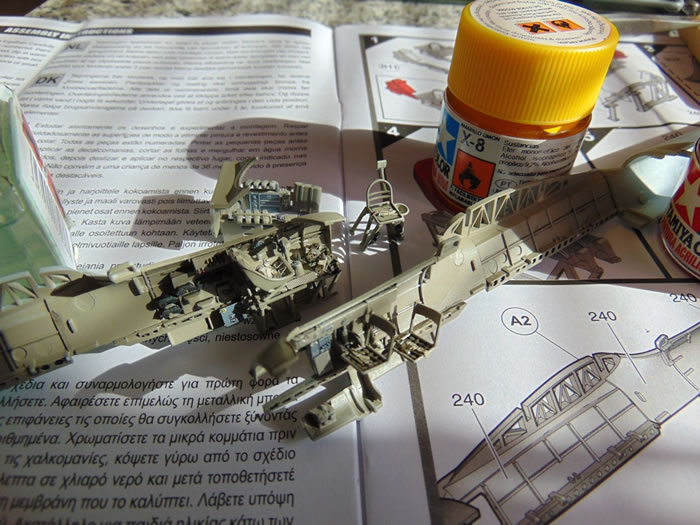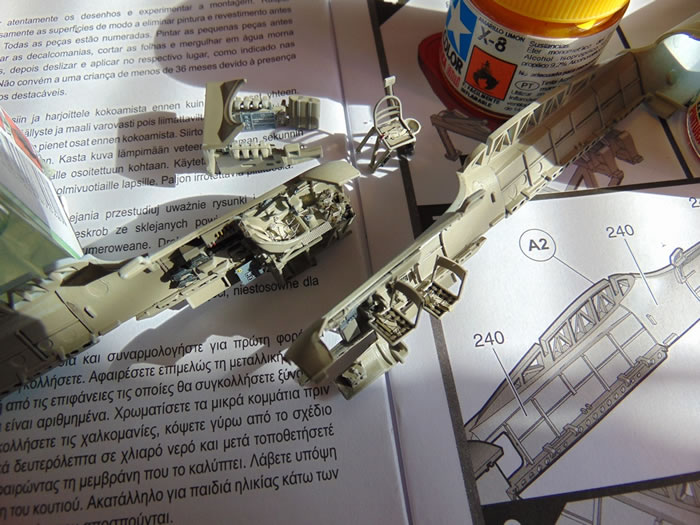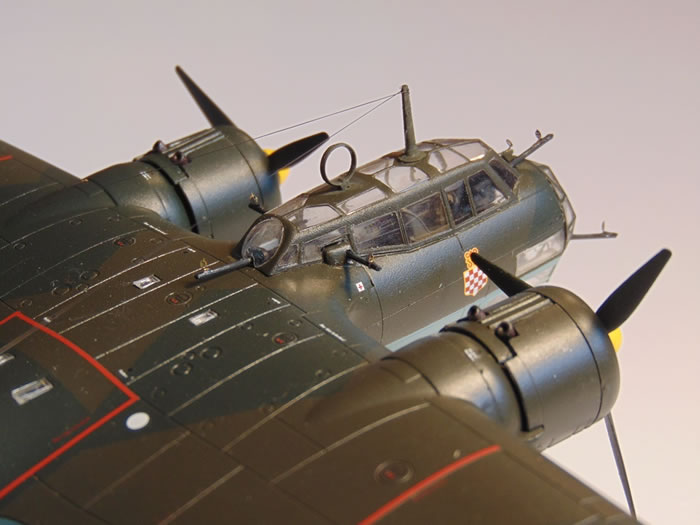Airfix 1/72 scale
Dornier Do 17 Z
(New Tooling)
by Roger Hardy
 |
Dornier Do 17 Z |

Hasegawa's 1/72 scale B-47E Stratojet is available online from Squadron
S
u m m a r y |
| Catalogue Number: |
Airfix Kit No. A05010 - Dornier Do 17 Z |
| Scale: |
1/72 |
| Contents and Media: |
Injection moulded. Four sprues of 160 light grey plastic parts; one sprue of 10 clear parts; markings for two aircraft. |
| Price: |
£14.16 (Export) or 16.99 (EU price) plus shipping from Hannants
and specialist hobby retailers worldwide |
| Review Type: |
Full build review straight-from-the-box. |
| Advantages: |
Current technology kit, accurate, comprehensive, well detailed. |
| Disadvantages: |
No ventral towel.rail antenna or swastika decals. There was some slight warping and distortion on my example. |
| Conclusion: |
Close to perfection. Highly recommended. |
Background
 History (see http://en.wikipedia.org/wiki/Dornier_Do_17) History (see http://en.wikipedia.org/wiki/Dornier_Do_17)
The Dornier Do 17, sometimes referred to as the Fliegender Bleistift ("flying pencil"), was a World War II German light bomber produced by Claudius Dornier's company, Dornier Flugzeugwerke. It was designed as a Schnellbomber ("fast bomber"), a light bomber which, in theory, would be so fast that it could outrun defending fighter aircraft. The prototype was originally inteneded to be a fast mail plane and passenger transport but was rejected by Deutsche Luft Hansa as being too cramped. Development continued on the military bomber variant which was revealed to the general public in 1937 at a military air show in Zurich.
The Dornier was designed with two engines mounted on a "shoulder wing" structure and possessed a twin tail fin configuration. It was powered by two BMW Bramo 323 Fafnir 985HP 9-cylinder radial engines, based heavily on Siemens/Bramo's earlier experience producing the Bristol Jupiter under license. The engine was not particularly modern and saw limited use. The type was popular among its crews due to its handling, especially at low altitude, which made the Do 17 harder to hit than other German bombers. Typical of all German bomber designs, all of the crew were contained in the cockpit module for reasons of morale and team spirit.
Designed in the early 1930s, it first flew in 1934 and was one of the three main Luftwaffe bomber types used in the first three years of the war. The Do 17 made its combat debut in 1937 during the Spanish Civil War, operating in the Condor Legion in various roles. Along with the Heinkel He 111 it was the main bomber type of the German air arm in 1939–1940. The Dornier was used throughout the early war, and saw action in significant numbers in every major campaign theatre as a front line aircraft until the end of 1941, when its effectiveness and usage was curtailed as its bomb load and range were limited; its bomb load was normally a mere 500kg.
Production of the Dornier ended in the summer of 1940, in favour of the newer and more powerful Junkers Ju 88. The successor to the Do 17 was the larger Dornier Do 217, which started to appear in strength in 1942. Even so, the Do 17 continued service in the Luftwaffe in various roles until the end of the war, as a glider tug, research and trainer aircraft. A considerable number of surviving examples were sent to other Axis nations as well as countries like Finland. Few Dornier Do 17s survived the war and the last was scrapped in Finland in 1952. No complete Do17z survives
On 3 September 2010, the Royal Air Force Museum London announced the discovery of a Henschel-built Dornier Do 17Z buried in the Goodwin Sands off the coast of Kent, England. On 10 June 2013, the salvage team successfully raised the airframe from the seabed, see http://www.rafmuseum.org.uk/cosford/things-to-see-and-do/dornier-17-conservation.aspx.
The Kit
The kit was comprehensively reviewed in the box by Mark Davies so I won’t repeat it here: http://www.hyperscale.com/2015/reviews/kits/airfixa05010reviewmd_1.htm
The choice of 1/72 models of the Do17Z has been limited to Frog/Revell and Monogram as Airfix missed this aircraft and plumped straight for the Do217 instead in 1959.
The Monogram kit I always liked but am told that it has some accuracy issues and all of these models are 1960s technology.
RS Models have a range of most of the Do17 variants (except the 17 Z) but I haven’t built them so cannot comment except to say that they are limited run kits but I have always liked RS Models.
Anyway, this is the all-new Airfix kit so I couldn’t wait to get down to it. A first sight, it looks pleasingly comprehensive and exceptionally well detailed with all of the cockpit and bomb bay detail there, including all of the visible the internal structure. It also includes separate control surfaces so all can be positioned as you like. The high parts count tells you that this isn’t going to be a quick and dirty build. Many of the parts are very fine, especially the undercarriage retraction struts, and care is needed to avoid breakages when removing them from the sprues.
Okay, my normal gripe: I know that Airfix is basically paint-maker Humbrol and they want to sell Humbrol paints but I prefer to use Tamiya so it’s necessary to refer to paint-equivalent charts. This is probably the best one: http://www.ipmsstockholm.org/colorcharts/stuff_eng_colorcharts_humbrol.htm although it doesn’t include their latest authentic colours.
Construction starts with the office and this one is really nice because it includes a massive amount of detail as separate parts rather than moulding them into the fuselage sides. This is a realistic touch and makes the cockpit look correctly three-dimensional and makes any future resin replacement set entirely superfluous.

The cockpit goes together with precision and looks good; the instrument panel is a decal but I also had the Eduard p/e set which I used as the panel is quite visible. I added the pre-painted Eduard harnesses, although if you include the nicely-moulded crew figures, you don’t need to bother. The p/e set has two frets, one standard brass, the other pre-coloured and self-adhesive, which I really like as I’m fundamentally lazy. You need to be careful you don’t compromise the sticky backs with dirty fingers. For cockpits, I tend only to use instrument panels and seat belts from p/e sets as the remaining parts are rather two-dimensional or cannot be seen or are so small that they are next-to impossible to handle. I elected to retain the three-dimensional radio parts that Airfix provide rather than the flat replacement that Eduard offer but that’s just me. The cockpit is so well-detailed that it seems almost a shame to close up the fuselage sides. The only gripe is that the forward crew seat on the starboard (right) fuselage side does not fit quite as intended but is easy to fix by dropping a dab of glue to the top corner of the seat back.

Before gluing the fuselage halves together, do not install the tailwheel or cut off the little lugs (step 10), this is for the wheels-up option. I did. Dumbo. Assembly step 6 is the surroundings for the rear gunner and it is not clear what angle the side panels should be. I cemented them parallel but this was a mistake and they should be angled outwards towards the open end, otherwise if will not fit properly into the fuselage in Step 18. In fact the illustration at Step 18 shows the correct angle for these side panels. I got it to fit by resorting to pressure (a lot) and superglue. The instructions recommend fitting the lower rear glazing (part E3) at this point but I avoided this although it is useful to temporarily tape it in place to ensure that Assembly 6 is correctly located.
The cockpit interior is mostly Humbrol 240 which is a new colour (not on the chart) but is RLM02, a light greenish-grey which I sprayed after most of the cockpit interior had been assembled. When dry, I applied some thin black wash around features and, when that was dry, some dry-brush white for highlights. I find that this general treatment looks more realistic than slavishly painting individual bits and pieces.
The Eduard instrument panel is very nice but then so is the decal provided by Airfix. The panel is quite visible so worth a little care. The purist will probably want to add the instrument bodies to the front of the panel as it can be clearly seen through the nose glazing.
Once the fuselage is all stitched up, the next step is adding the upper wing. I found I needed to trim the inside edges of the front wing root to get it to fit properly but, once this was done, the fit was better although it will still need a little filler at the front. I noticed that the bomb bay opening on one side is slightly curved probably due to a slightly warped fuselage side that I had not noticed before. It’s not serious but I cannot rectify it at this stage. On that subject, the fine undercarriage retraction struts B6 and B8 were also distorted and needed to be bent back to shape. I suspect the sprues may have been taken out of the mould too early.
I found that one of the lower wing panels had a small gap between the root and the fuselage so I filled this with 0.010” plastic card to ensure rigidity. The other side fitted OK. The Eduard p/e parts that fit inside the nacelles are very fiddly and one of the parts lacked the fold scribing so could not be used. Frankly, these parts are really not necessary and simply stop the lower cowling parts from fitting properly. If I were doing it again, I’d leave them all out.
I found that I needed to fettle the nacelle fronts to get them to blend into the nacelle parts on the wing and this is because the mismatch I found when fitting the wing halves together chases through to the nacelles. The engines are little gems and look very good, deep down inside those cowlings. All of the exhaust assembly is provided so these look good whichever way you look at them. I left the engines and cowlings off for later assembly.
Once all the major assemblies are brought together most of the seams need a little cleaning up and I used Milliput and very fine wet-and-dry paper. I decided to install the undercarriage as I expected this to be tricky and did not want to damage the paint job. In fact, installing the undercarriage was easier than I had expected but you need to be careful with the retraction struts as they are so fine (and mine were distorted). Next comes the bomb bay and you have a choice of little bombs or bigger ones and fuel tank. I elected for the tank plus one bomb. The bomb colours are Humbrol 241, another new colour but it’s RLM70, Schwartzgrün. Then came the undercarriage and bomb bay doors which I added at this stage to make the joints more secure and the masking easier. I didn’t bother with the Eduard p/e bits as I’d got rather fed up with the way they just seemed to interfere with the fit of the original parts. In any case, these undercarriage doors have 3-D curves and the p/e is 2-D. You’d think I’d have learned my lesson by now. The transparencies have machine guns bristling out of them and these have to be inserted before they are fitted permanently. Therefore I left them off until after painting to avoid knocking off the gun barrels.
Painting
I use the Aztek A470 air brush with turquoise nozzle (high volume - nothing fancy – never blocks!) and Tamiya colours.
I used the Eduard transparency masks which save a lot of time for this complex glazing. I have found that they work very well. I then tacked the transparencies to the model with Micro Kristal Kleer which is like white glue but the bond is weak and it can be removed before using liquid poly for the final assembly. I then sprayed them RLM02 for the interior colour. I masked the bomb bay and undercarriage assemblies and primed the model with Alclad grey microfiller and primer (white for the underside). Then I sprayed the yellow wing tips and masked them off before spraying the RLM65 underside with Tamiya XF-23. The upper surface is RLM70/71, Tamiya XF-27 and 61, splinter camouflage using hard-edged masking (kabuki tape). Actually, after the model was sprayed, I felt that there was too little contrast between two greens and that I should in future lighten the XF-61 as XF-27 looks about right. Next is to spray the whole model with Alclad Gloss in preparation for the decals.

Just a brief word about Alclad’s general finishes. They’re famous for their state-of-the-art metal finishes but they also now do a range of overall varnishes: matt, slight sheen, satin, gloss and ‘aqua’ (used for protecting the high reflective paints) plus the primers, grey and white. I’ve struggled for years to find reliable primers and general finishes (in particular, a good satin varnish) and had hit on Tamiya’s rattle-cans which are good but expensive. Alclad’s new general finishes are actually just as good but have the advantage that they come in BIG bottles (120ml…Tamiya paints are 10ml) and can be sprayed as they are already the correct consistency. On the model they give the correct sheen without giving any impression of depth, so you feel confident in applying multiple coats without seeing any build-up of thickness. Nice. They all work as advertised and I recommend them without reservation.
Decals
There are no swastikas (in German, ‘Hakenkreutz’) included on the decal sheet and I don’t really understand this. I lived in Germany for seven years and know that public display of the Hakenkreutz is illegal and many Germans feel queasy just seeing it. This is why Revell GmbH never include Hakenkreutze in their kits and I can understand that. However, other manufacturers get around this by splitting the swastika into two inoffensive shapes and this leaves it up to the modeller to decide whether he wants to use them or not. I do not understand why Airfix cannot do this. If it’s good enough for Hasegawa and Tamiya…..come on guys. Fortunately, Hannants do sets of swastika decals in all scales in the Xtradecal range and these cover all sizes and styles of swastikas used. Here is the sheet for 1/72 scale: http://www.hannants.co.uk/product/X72036. The decals are matt and decent quality. I had a tiny bit of silvering on one underwing cross but that was all. I used Microset but I don’t think it was really necessary.
When dry, I sprayed the whole model with Alclad Matte, then removed the masking from the transparencies. Incidentally, these masks seem to be immune from bleed-through.
Final Bits and Pieces
The engines and wheels are then added plus the various transparencies with guns inserted.
Airfix provides a DF loop but also offers a fairing that does not feature in the instructions. I suspect that it was meant to be the mount for the DF loop but many photos do not show it so I didn’t use it.
There are various aerials and a pitot to add. Finally, I added the aerial wires from the mast to the fins from EZ-line.
I note from some drawings that there is a towel-rail aerial under the rear fuselage but this is not included in the kit which is strange unless Airfix know more than I do. I didn’t add one and none was included on the Eduard p/e fret.

Whereas I felt that much of the p/e fret(s) was not particularly useful, the Eduard canopy masks are an essential for a model like this with such complex glazing and I strongly recommend investing in a set. They are easier to use than you’d think and give a result better than you might expect.
Anyway, straight from the box to the shelf, this new Do17z really looks the part and I am very pleased with the resulting modeI. It looks accurate to me. This kit clearly makes the venerable Frog/Revell and Monogram offerings obsolete and I am pleased that Airfix are once again producing high quality kits at pocket money prices which might encourage more youngsters to take up the hobby.
Highly recommended!
Model, Images and Text
Copyright ©
2015 by Roger Hardy
Page Created 15 April, 2015
Last Updated
15 April, 2015
Back to HyperScale Main Page
|
Home
| What's New | Features | Gallery | Reviews | Reference | Resource Guides | Forum |